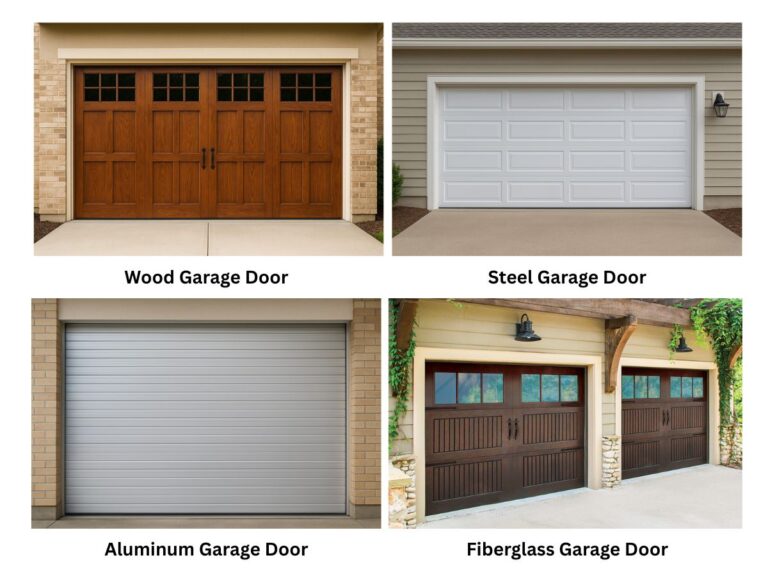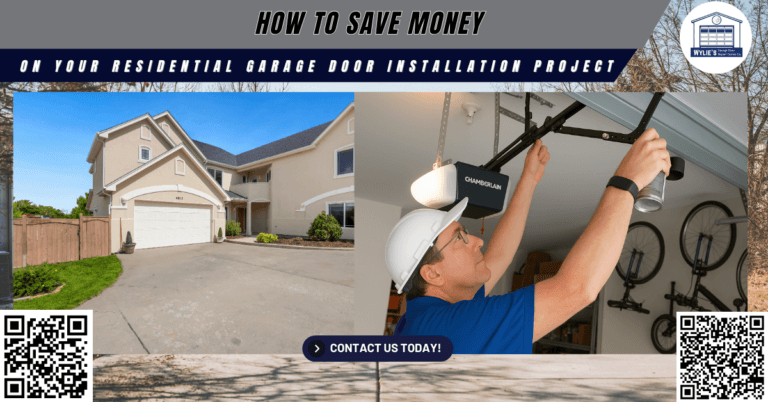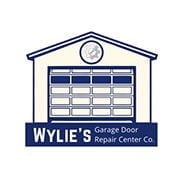How to Save Money on Your Residential Garage Door Installation Project
By Wylie’s Garage Door Repair Center Co. – Trusted Garage Door Experts in Wylie, TX
When the Martins moved into their new home in Wylie, TX, they were thrilled about the fresh start. But their excitement was quickly tempered when they realized their old garage door was not only outdated, but it also posed safety concerns and significantly affected the home’s curb appeal. They were quoted over $2,000 for a new garage door installation. Fortunately, they found Wylie’s Garage Door Repair Center Co., and with our expert guidance, they selected the right materials, avoided unnecessary features, and ensured a professional garage door installation that cost them far less than expected.
Statistics show that installing a new residential garage door can provide up to a 94% return on investment (ROI), making it one of the smartest upgrades for homeowners. However, the final cost of your residential garage door installation can vary widely depending on the materials, features, and installation process.
This comprehensive guide will show you exactly how to save money while getting a durable, efficient, and safe garage door. From insulation and spring tension to horizontal tracks and garage door openers, we’ll walk you through every step with easy-to-follow tips.
Understand Your Garage Door Needs
Before selecting a garage door, take time to assess your home’s specific needs. This step is crucial in avoiding overspending and ensuring proper operation.
Consider These Key Factors:
- Garage Type: Is it attached or detached? Attached garages affect your home’s energy efficiency more directly.
- Usage: Will it be used for storage, a workshop, or only parking? This impacts insulation and opener features.
- Climate: In Wylie, TX, heat and humidity are factors. Look for materials and insulation that can handle the local weather.
A successful garage door installation starts with choosing the right garage door system for your space. Factors such as door size, garage door opening dimensions, insulation needs, and opener compatibility should be considered from the beginning.
Energy Consideration:
For attached garages, an insulated garage door with a high R-value reduces energy consumption and maintains indoor temperature. A door with a steel core and polyurethane insulation offers durability and energy efficiency in one.
Choose the Right Materials and Style
The type of material you choose directly impacts the cost, durability, and maintenance needs of your new garage door. Let’s break down the options:
Garage Door Materials:
- Steel Garage Doors: Popular for durability, affordability, and minimal maintenance. They can include multiple garage door panels and can be insulated.
- Aluminum Doors: Lightweight and rust-resistant, ideal for wider garage door openings. Not the best for insulation.
- Wood Garage Doors: Aesthetic and classic, but require ongoing maintenance and are more expensive.
- Fiberglass or Vinyl Garage Doors: Resistant to dents and corrosion, but may lack the same strength or insulation.

Garage Door Styles:
Choose a style that complements your home, carriage house, modern flush, or traditional raised-panel designs. These doors come with varied features, including windows, custom panel sections, and decorative hardware.
Money-Saving Tip: Skip luxury finishes and opt for steel with basic panels for long-term savings and durability. You’ll still get the benefit of a sleek look without the higher price tag.
Reuse Existing Hardware When Appropriate
A savvy way to reduce cost during your garage door installation is to reuse existing garage door hardware, but only when it’s safe.
Reusable Parts (Depending on Condition):
- Garage door opener
- Tracks (horizontal and vertical tracks)
- Torsion tube and torsion springs
- Hinges, brackets, drums, and cables
- Ceiling mounts and center brackets
Always have a professional technician inspect these components to ensure they meet current standards and align with your new garage door system.
Warning: Old or mismatched parts can lead to poor operation, safety risks, or void manufacturer warranties. Never reuse hardware that shows signs of wear, corrosion, or bent sections.
Insulation and Energy Efficiency Considerations
Insulated garage doors can cut your utility bills, especially for garages that are attached to your living space.
Understanding Insulation:
- Polystyrene insulation: Cost-effective, but provides moderate insulation.
- Polyurethane insulation: Offers better thermal resistance and structural integrity.
- R-value: Measures thermal efficiency; the higher the number, the better.
Other Features That Improve Energy Efficiency:
- Bottom seal: Prevents air leaks at the bottom panel.
- Weatherstripping: Seals gaps around the door frame.
- Insulated panels: Help maintain indoor climate.
Money-Saving Tip: A mid-range insulated steel door with proper sealing and weatherproofing can offer excellent value over time.
Get Several Quotes and Compare Services
Before making a decision, get multiple quotes from trusted garage door companies. This helps you compare:
- Cost of materials and labor charges
- Types of garage doors offered
- Installation steps are included in the service
- Warranty terms for both the door and the opener
- Reputation, local reviews, and response time
Beware of vague estimates that don’t list materials like brackets, springs, or garage door openers.
Tip: Choose local, licensed professionals like Wylie’s Garage Door Repair Center Co. for honest pricing and reliable service.
Avoid Overpaying for Unnecessary Add-ons
There are dozens of garage door features available, but not all are essential.
Think Twice Before Adding:
- Smart garage door openers (unless needed)
- High-end decorative hardware
- Custom top sections or glass panels
- Color-matched paneling or wood grain finishes
What Matters More?
- Smooth door operation
- Durable panels and hinges
- Proper track alignment
- Torsion spring balance
Money-Saving Tip: Focus on performance and safety features like torsion springs, cable drums, safety sensors, and flag brackets, not aesthetic extras.
DIY Preparation Steps to Save on Labor
If you’re comfortable doing some prep work, this can reduce your total installation time and cost.
What You Can Do:
- Clear the garage contents from the work area
- Disconnect the old door opener
- Remove light fixtures that may obstruct the tracks
- Mark the garage opening dimensions for panel fitting
What You Should Leave to Pros:
- Spring tension adjustments
- Torsion spring mounting
- Vertical and horizontal track installation
- Center and flag bracket placement
Attempting technical steps without the necessary tools (like vise grips, zinc hex lag bolts, and a tension rod) can be dangerous and result in improper setup.
Maintain Your Garage Door Regularly
Once your garage door is installed, regular maintenance can prevent costly repairs and extend its life.
Maintenance Checklist:
- Lubricate rollers, hinges, and springs
- Inspect cables, safety sensors, and tracks
- Test the garage door opener and photo-eye sensors
- Tighten brackets and bolts
Money-Saving Tip: Schedule routine maintenance annually with professionals to catch small problems early, especially if your system includes torsion springs, which operate under high tension.
Work With Licensed and Insured Professionals
Your garage door is the largest moving object in your home. It’s a complex system involving:
- Heavy panels
- High-tension springs
- Cables and drums
- Electric openers
- Safety sensors
For safe operation and long-lasting performance, the installation must follow detailed manufacturer installation instructions and include all garage door sections, from bottom panel to top section.
Professional installation ensures:
- Correct spring tensioning
- Aligned tracks and panels
Balanced door operation - Compliance with safety standards
Final Tips for a Successful Garage Door Installation
Step | Key Considerations |
1. Assess Needs | Climate, usage, and garage layout |
2. Choose Materials | Steel for value, insulation for efficiency |
3. Plan Budget | Compare prices and avoid add-ons |
4. Prepare Site | Clear space and review the layout |
5. Install Professionally | Leave spring and track work to experts |
6. Maintain Regularly | Lubricate, inspect, and test yearly |

How Can Wylie’s Garage Door Repair Center Co. Help You?
At Wylie’s Garage Door Repair Center Co., we specialize in helping homeowners just like you make smart, cost-effective choices. Whether it’s selecting the right door material, configuring your garage door opener, or adjusting spring tension and brackets, we’ve got you covered.
Our expert technicians follow every step of the garage door installation process, from measuring your garage opening and installing torsion springs to setting up your garage door opener for smooth, safe operation.
Why Choose Us?
- ✅ Local expertise with decades of experience
- ✅ Affordable pricing and transparent quotes
- ✅ High-quality doors, openers, and parts
✅ Fast, professional installation - ✅ Ongoing support and maintenance plans
📍 Visit Us: 111 E Farm to Market Rd 544, Wylie, TX
📞 Call Us Today: +14698385939
Let’s make your garage door installation project a success without breaking the bank. Call now for your free quote or to schedule a consultation with one of our expert technicians.
Frequently Asked Questions (FAQs)
1. How long does it take to install a new residential garage door?
Most professional garage door installations take between 4 to 6 hours, depending on the complexity and condition of the existing structure.
2. Can I install a garage door myself to save money?
While DIY installation is possible, it can be dangerous due to the tension in torsion springs and the need for precise alignment, professional installation is highly recommended for safety and longevity.
3. What type of insulation is best for garage doors in Texas?
Polyurethane insulation is ideal for Texas weather as it provides higher R-values, better energy efficiency, and superior temperature control.
4. How do I know if my garage door opener is compatible with a new door?
Check the opener’s weight capacity and age; most modern openers work with new doors, but older models may lack the strength or features needed for smooth operation.
